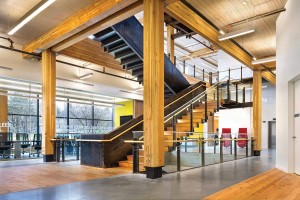
Award of Excellence: Mountain Equipment Co-op Head Office
October 24, 2015
By Fast + Epp
“This mid-rise commercial building in Vancouver is a hybrid timber and steel structure, with an extensive use of wood. It seems relatively simple construction, but the engineers had to work from first principles. The interface of the floor diaphragm with the steel lateral system, for example, needed careful design to meet the intent of seismic requirements in the code.” – Jury
From the October-November 2015 print edition, p. 41

Mountain Equipment Co-op Head Office, Vancouver. Photo: Ed White.
For its new head office in Vancouver’s False Creek Flats area, Mountain Equipment Co-op wanted to create a workplace that would inspire its employees to do their best work: a central atrium gathering space and open offices to encourage collaboration; natural building materials; abundant daylight and fresh air; use of sustainable building strategies and energy and water efficiency. Feedback from the company’s 300 head office employees allowed the design team to refine elements in response to their needs. The designers set LEED Gold as a minimum standard (the final review is still in progress), and many aspects of the design targeted LEED Platinum.
In keeping with the company’s trend towards using wood as a major element in its retail stores, and to provide a warm aesthetic to the interior, wood became the material of choice for the 110,000 sq. ft. building. Two narrow floor plates — one four-storeys tall and the other three storeys with a rooftop garden — intersect at a 40-degree angle, creating a central atrium inside the building.
The non-traditional combination of structural timber (more than one million board feet) and steel required a “first principles” approach to design and detailing. Glulam beams and columns and nail-laminated timber (NLT) floor panels make up the majority of the structure. Wherever possible, these elements are left exposed to view.
Nail-laminated timber
Nail-laminated timber — dimensional lumber placed on edge and nailed together into a solid deck — is a very simple structural system. Common in warehouse construction at the turn of the 20th century, it has since fallen out of favour. The use of NLT floors for this building presented three major technical hurdles:
• There are no industry standard specifications or design guides for NLT floors, so great care was taken to properly document the structural and the aesthetic requirements for the finished product.
• The design of the NLT floor diaphragm and its interface with the steel lateral system had to meet modern building codes. In high-seismic regions like Vancouver, codes encourage designs that provide an energy-dissipating fuse (in this case the steel braces), while other elements, such as the floor diaphragm, are intended to remain elastic. In light-frame wood buildings, plywood sheathing over wood joists creates a flexible diaphragm, but in this case, the floor is expected to behave more rigidly. The floors were designed with sufficient reinforcing and redundancy to ensure they meet the intent of the code.
• Vancouver’s wet climate is a particular challenge for wood structures, so temporary protection of the wood was required during construction. As well, NLT panels were pre-fabricated off-site and put into place by crane to speed up erection.
With heavy timber to resist gravity loads, the structure relies on steel buckling-restrained braced frames to resist lateral loads rather than a shear wall system. The majority of office spaces are open plan, with extensive glazing at the perimeter to maximize daylight. In cases such as these, walls are often provided at the mechanical cores. However, ventilation in the building involves three central “wind towers” to collect air, which is then supplied to the building through plenum spaces. The large openings required above the floor diaphragm to feed these plenums prohibited the use of solid walls at the wind towers.
Far-reaching effects
To capitalize on the success of this project, the Canadian Wood Council funded a study to demonstrate the cost-competitiveness of wood structures; it is also contributing to the development of an NLT design guide.
Conducted by a team including Fast + Epp, the Council’s cost study was a comprehensive look at how the building would compare to a similar building constructed with structural steel or reinforced concrete. The cost of the structure, as well as associated impacts on the cost of other systems such as envelope, mechanical-electrical and finishes, and the impact on construction time and soft costs like insurance were all considered. The study shows that wood can actually be cost-competitive with steel and concrete, when considered as part of a total construction budget.
Fast + Epp also have a proposal before the Council to develop industry standards for NLT. While glulam and other engineered wood products are well-documented in the Canadian wood codes and suppliers’ literature, little information is available for NLT, which impedes its use on a wider scale.
Project name: Mountain Equipment Co-op Head Office,
Vancouver
Award-winning firm (structural sub-consultant):
Fast + Epp (Paul A. Fast, P.Eng., Tanya Luthi, P.E.,
Julien Fagnan, P.Eng.)
Owner: Mountain Equipment Co-op
Other key players: Pageau Morel (electrical-mechanical
engineering), GeoPacific Consultants (geotechnical),
Kerr Wood Leidal (civil), LMDG (code), Ventana
Construction (general contractor)